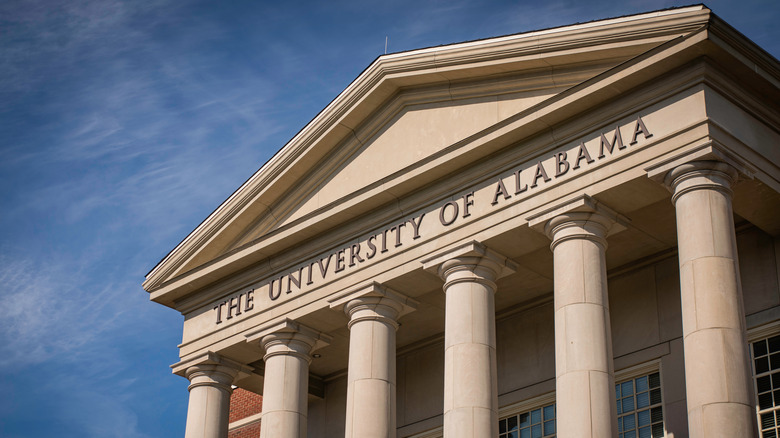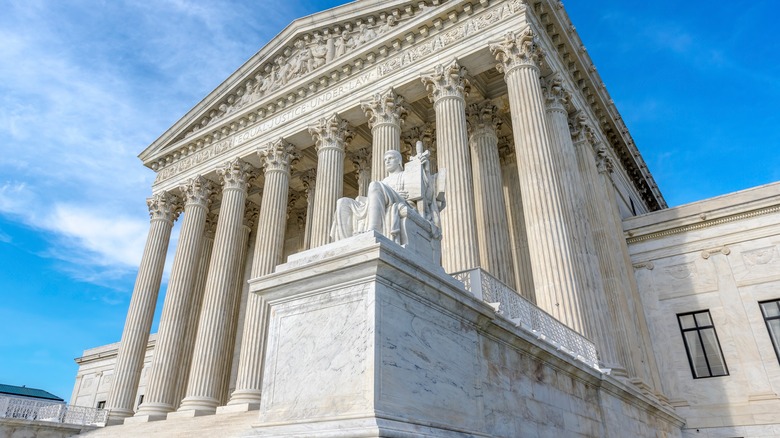The Sad Reason The University Of Alabama Expelled Its First Black Student In 1956
These days, about 11% of the students enrolled at the University of Alabama are Black, according to Data USA. However, a few decades ago, that figure was zero percent, and certain people in power were keen to see it kept that way. As the National Museum of African American History and Culture reports, the university was founded in 1831, and for the next century or so, an unofficial "whites only" policy ruled the day. However, that changed in 1952 when two Black women enrolled in the university's graduate program, only to have their admissions rescinded when university officials realized the women were Black.
It would take several years and a Supreme Court decision — relating to the matter of Blacks in public education — before the two women were finally allowed to attend class. Once there, they were harassed by other students. The university's administration found reasons to expel both of them.
Autherine Lucy and Pollie Anne Myers
Although the education options for Black women were limited in those days, and in particular, the higher education options for Black women, Autherine Lucy and Pollie Anne Myers managed to overcome overwhelming odds and complete their undergraduate educations. Specifically, according to the National Museum of African American History and Culture, they both got their bachelors degrees from Miles College which, according to the college's website, is an historically Black college/university (HBCU). When the two women began thinking about furthering their education, Myers suggested graduate school at the University of Alabama. "I thought she was joking at first, I really did," Myers would later say.
In the fall of 1952, the two women were welcomed at the University — until they weren't. They were admitted following their "inquiry letters, but then when they submitted applications, which included their race, their admission was rescinded.
It would take three years and a Supreme Court case — not necessarily involving the two women directly, but a matter adjacent to their cause — before the women could set foot on the campus. Even then, their ordeal was far from over.
A Supreme Court Decision Changes Everything
There's a reason Brown v. The Board of Education of Topeka is considered a "landmark" Supreme Court case. Not only did it throw out precedent and set a new one, it also fundamentally changed the face of public education in the United States, including higher education. As History reports, and to make a very long story very short, the 1954 case ruled that the "separate but equal" doctrine resulted in conditions for Blacks in schools that were anything but equal, and effectively ended racial segregation in public schools.
This case had little to do, directly, with Lucy and Myers, although it did set a precedent that paved the way for their own legal challenges to the denial of their right to attend school at the University of Alabama. According to Time, the Supreme Court directly instructed Federal Judge Harlan Grooms to order the university to admit the two women.
Three years after applying to the university, they two women were finally able to begin attending classes. However, their ordeal was just beginning.
Harassment And Expulsion
Forced by a court to accept two students it didn't want, the students and administration of the University of Alabama began a campaign of harassment against them.
Myers, in fact, never even made it there. Authorities hired private investigators to look into the pasts of the two women, according to the National Museum of African American History and Culture, and when they found that she had gotten pregnant out of wedlock, her admission was rescinded for having violated the school's morality code. Lucy was on her own.
Within days, students would mob her and hurl racist epithets at her. She was denied the privileges of living at the school's dorms or eating in the dining halls. At certain points, she had to be escorted by university officials across campus. Eventually, the university decided to remove her "for her own protection." Attorneys filed a complaint on her behalf, and the school decided that she had defamed them, so she, too was expelled.
Autherine Lucy's Legacy
Following her expulsion from the University of Alabama, a lawyer who had filed on her behalf invited her to live with her in New York. His name was Thurgood Marshall, according to the Library of Congress, and he would later be appointed to the United States Supreme Court. "I just felt so secure with Mr. Marshall and his wife. . . . How grateful I have been over all these years for the protection and the kindness he gave to me," she would later say.
Her name was toxic in the South, however, and she struggled to find acceptance and employment. Eventually she and her family settled in Birmingham, and she began a teaching career, according to the New York Times.
The University of Alabama, for its part, did right by Lucy by officially rescinding her expulsion in 1988, and in 1989, according to the National Museum of African American History and Culture, she once again attempted to complete her master's program at the university. This time, she succeeded. In 1992, she earned her degree, and shared the commencement stage with her daughter, who also received a degree that year.
The university has since created a scholarship in her name and, according to University of Alabama News, dedicated a clock tower in her honor.



